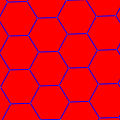Snub trihexagonal tiling
In geometry, the snub hexagonal tiling (or snub trihexagonal tiling) is a semiregular tiling of the Euclidean plane. There are four triangles and one hexagon on each vertex. It has Schläfli symbol sr{3,6}. The snub tetrahexagonal tiling is a related hyperbolic tiling with Schläfli symbol sr{4,6}. Conway calls it a snub hextille, constructed as a snub operation applied to a hexagonal tiling (hextille). There are three regular and eight semiregular tilings in the plane. This is the only one which does not have a reflection as a symmetry. There is only one uniform coloring of a snub trihexagonal tiling. (Labeling the colors by numbers, "3.3.3.3.6" gives "11213".) Circle packingThe snub trihexagonal tiling can be used as a circle packing, placing equal diameter circles at the center of every point. Every circle is in contact with 5 other circles in the packing (kissing number).[1] The lattice domain (red rhombus) repeats 6 distinct circles. The hexagonal gaps can be filled by exactly one circle, leading to the densest packing from the triangular tiling. Related polyhedra and tilings
Symmetry mutationsThis semiregular tiling is a member of a sequence of snubbed polyhedra and tilings with vertex figure (3.3.3.3.n) and Coxeter–Dynkin diagram
6-fold pentille tiling
In geometry, the 6-fold pentille or floret pentagonal tiling is a dual semiregular tiling of the Euclidean plane.[2] It is one of the 15 known isohedral pentagon tilings. Its six pentagonal tiles radiate out from a central point, like petals on a flower.[3] Each of its pentagonal faces has four 120° and one 60° angle. It is the dual of the uniform snub trihexagonal tiling,[4] and has rotational symmetries of orders 6-3-2 symmetry. VariationsThe floret pentagonal tiling has geometric variations with unequal edge lengths and rotational symmetry, which is given as monohedral pentagonal tiling type 5. In one limit, an edge-length goes to zero and it becomes a deltoidal trihexagonal tiling.
Related k-uniform and dual k-uniform tilingsThere are many k-uniform tilings whose duals mix the 6-fold florets with other tiles; for example, labeling F for V34.6, C for V32.4.3.4, B for V33.42, H for V36: FractalizationReplacing every V36 hexagon by a rhombitrihexagon furnishes a 6-uniform tiling, two vertices of 4.6.12 and two vertices of 3.4.6.4. Replacing every V36 hexagon by a truncated hexagon furnishes a 8-uniform tiling, five vertices of 32.12, two vertices of 3.4.3.12, and one vertex of 3.4.6.4. Replacing every V36 hexagon by a truncated trihexagon furnishes a 15-uniform tiling, twelve vertices of 4.6.12, two vertices of 3.42.6, and one vertex of 3.4.6.4. In each fractal tiling, every vertex in a floret pentagonal domain is in a different orbit since there is no chiral symmetry (the domains have 3:2 side lengths of in the rhombitrihexagonal; in the truncated hexagonal; and in the truncated trihexagonal).
Related tilings
See alsoWikimedia Commons has media related to Uniform tiling 3-3-3-3-6 (snub trihexagonal tiling). References
External links |
||||||||||||||||||||||||||||||||||||||||||||||||||||||||||||||||||||||||||||||||||||||||||||||||||||||||||||||||||||||||||||||||||||||||||||||||||||||||||||||||||||||||||||||||||||||||||||||||||||||||||||
Portal di Ensiklopedia Dunia



































































































